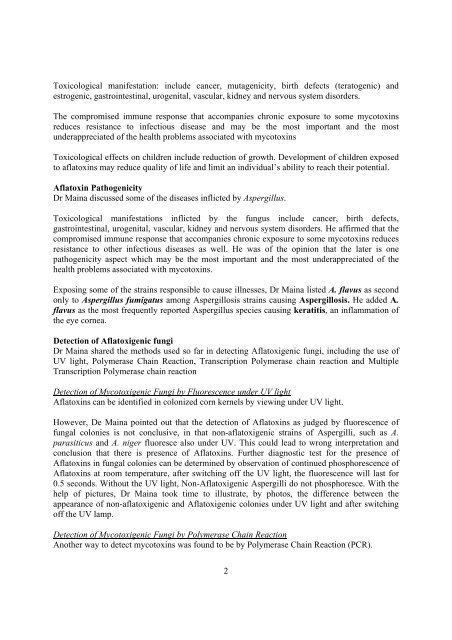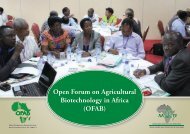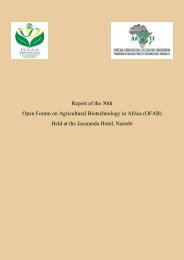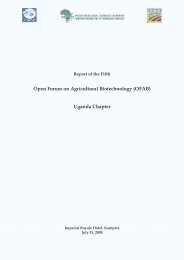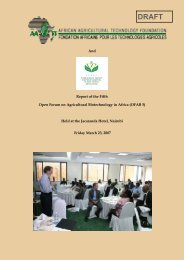Aflatoxin in Food: What Role for Biotechnology? - OFAB
Aflatoxin in Food: What Role for Biotechnology? - OFAB
Aflatoxin in Food: What Role for Biotechnology? - OFAB
You also want an ePaper? Increase the reach of your titles
YUMPU automatically turns print PDFs into web optimized ePapers that Google loves.
Toxicological manifestation: <strong>in</strong>clude cancer, mutagenicity, birth defects (teratogenic) and<br />
estrogenic, gastro<strong>in</strong>test<strong>in</strong>al, urogenital, vascular, kidney and nervous system disorders.<br />
The compromised immune response that accompanies chronic exposure to some mycotox<strong>in</strong>s<br />
reduces resistance to <strong>in</strong>fectious disease and may be the most important and the most<br />
underappreciated of the health problems associated with mycotox<strong>in</strong>s<br />
Toxicological effects on children <strong>in</strong>clude reduction of growth. Development of children exposed<br />
to aflatox<strong>in</strong>s may reduce quality of life and limit an <strong>in</strong>dividual’s ability to reach their potential.<br />
<strong>Aflatox<strong>in</strong></strong> Pathogenicity<br />
Dr Ma<strong>in</strong>a discussed some of the diseases <strong>in</strong>flicted by Aspergillus.<br />
Toxicological manifestations <strong>in</strong>flicted by the fungus <strong>in</strong>clude cancer, birth defects,<br />
gastro<strong>in</strong>test<strong>in</strong>al, urogenital, vascular, kidney and nervous system disorders. He affirmed that the<br />
compromised immune response that accompanies chronic exposure to some mycotox<strong>in</strong>s reduces<br />
resistance to other <strong>in</strong>fectious diseases as well. He was of the op<strong>in</strong>ion that the later is one<br />
pathogenicity aspect which may be the most important and the most underappreciated of the<br />
health problems associated with mycotox<strong>in</strong>s.<br />
Expos<strong>in</strong>g some of the stra<strong>in</strong>s responsible to cause illnesses, Dr Ma<strong>in</strong>a listed A. flavus as second<br />
only to Aspergillus fumigatus among Aspergillosis stra<strong>in</strong>s caus<strong>in</strong>g Aspergillosis. He added A.<br />
flavus as the most frequently reported Aspergillus species caus<strong>in</strong>g keratitis, an <strong>in</strong>flammation of<br />
the eye cornea.<br />
Detection of Aflatoxigenic fungi<br />
Dr Ma<strong>in</strong>a shared the methods used so far <strong>in</strong> detect<strong>in</strong>g Aflatoxigenic fungi, <strong>in</strong>clud<strong>in</strong>g the use of<br />
UV light, Polymerase Cha<strong>in</strong> Reaction, Transcription Polymerase cha<strong>in</strong> reaction and Multiple<br />
Transcription Polymerase cha<strong>in</strong> reaction<br />
Detection of Mycotoxigenic Fungi by Fluorescence under UV light<br />
<strong>Aflatox<strong>in</strong></strong>s can be identified <strong>in</strong> colonized corn kernels by view<strong>in</strong>g under UV light.<br />
However, De Ma<strong>in</strong>a po<strong>in</strong>ted out that the detection of <strong>Aflatox<strong>in</strong></strong>s as judged by fluorescence of<br />
fungal colonies is not conclusive, <strong>in</strong> that non-aflatoxigenic stra<strong>in</strong>s of Aspergilli, such as A.<br />
parasiticus and A. niger fluoresce also under UV. This could lead to wrong <strong>in</strong>terpretation and<br />
conclusion that there is presence of <strong>Aflatox<strong>in</strong></strong>s. Further diagnostic test <strong>for</strong> the presence of<br />
<strong>Aflatox<strong>in</strong></strong>s <strong>in</strong> fungal colonies can be determ<strong>in</strong>ed by observation of cont<strong>in</strong>ued phosphorescence of<br />
<strong>Aflatox<strong>in</strong></strong>s at room temperature, after switch<strong>in</strong>g off the UV light, the fluorescence will last <strong>for</strong><br />
0.5 seconds. Without the UV light, Non-Aflatoxigenic Aspergilli do not phosphoresce. With the<br />
help of pictures, Dr Ma<strong>in</strong>a took time to illustrate, by photos, the difference between the<br />
appearance of non-aflatoxigenic and Aflatoxigenic colonies under UV light and after switch<strong>in</strong>g<br />
off the UV lamp.<br />
Detection of Mycotoxigenic Fungi by Polymerase Cha<strong>in</strong> Reaction<br />
Another way to detect mycotox<strong>in</strong>s was found to be by Polymerase Cha<strong>in</strong> Reaction (PCR).<br />
2


